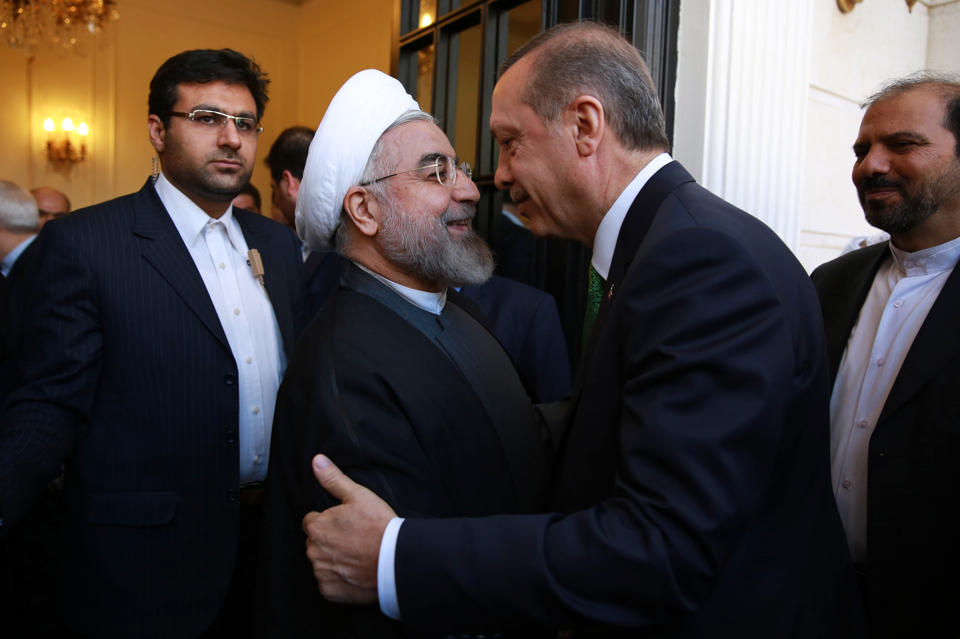The 1979 departure of Mohammad Reza Shah Pahlavi from Iran, followed by the return of Ayatollah Ruhollah Khomeini, provoked mixed feelings in Turkey. Initially, many in Turkey saw these developments as a reaction to the repression and human rights abuses perpetrated by the shah. However, once the theocratic nature of the regime became evident and Iran broke away from the Western alliance, concerns in secular Turkey emerged about Iran fomenting both Islamism and Kurdish nationalism.
In due course, Turkey learned to co-exist with Iran’s new regime and during the subsequent 40 years, relations between the two countries settled into a pattern of ups and downs from that of previous decades, if not centuries. The 1639 Qasr-i Shirin treaty between the Safavid and Ottoman Empires, which ended long rounds of territorial wars between them, left a legacy of coexistence and a disinclination on both sides toward escalation. After the Iranian revolution, this tradition of moderation evolved into pragmatism that enabled mutual tolerance between their diametrically opposed regimes. Ironically, in recent years as Turkey’s secular credentials and democracy have weakened, a degree of regime convergence around political Islam, albeit representative of two distinct branches of Islam, has followed.
THE COURSE OF IRANIAN-TURKISH RELATIONS SINCE 1979
The revolution occurred against a background of poor relations between the shah’s Iran and Turkey. Turkey’s policy of hosting Iranian dissidents, including Ayatollah Khomeini during his early exile, and the shah’s active support for Kurdish separatism in Iraq in the early 1970s especially taxed the bilateral relationship. For this reason, Turkey initially welcomed the revolution, and its anti-American narrative was quite popular among the Turkish public. The left-leaning Turkish government led by Bülent Ecevit welcomed Iran’s withdrawal from the Central Treaty Organization (CENTO) and sought to expand economic relations with Tehran. Ecevit sent his foreign affairs minister on an official visit in June 1979 and his reception by Khomeini seemed to signal goodwill.
However, the honeymoon soon ended. Turkey’s change of government, compounded by the shock of the hostage crisis and the September 1980 military coup, created a very different climate. The military saw Iran’s increasingly theocratic regime as a threat to Turkish secularism and national security, while Tehran viewed Turkey as the “devil’s servant” aspiring to undermine the revolution.
Reciprocal threat perceptions and deep mistrust persisted during the 1990s and into the new millennium. For example, Iran constantly criticized Turkey for restricting women who wear hijab (Islamic veiling) from accessing higher education and holding public office. In contrast, Turkey considered Tehran’s enforcement of compulsory hijab as backward and unmodern. Close Israeli-Turkish cooperation especially in the military realm provoked Iranian anxieties, as did concerns about Turkish nationalism as a source of agitation among its Azeri minority. In turn, Turkey accused Iran of supporting the secessionist Kurdistan Workers’ Party (PKK) and even risked militarized confrontation by sending troops in hot pursuit of PKK militants and even sending military aircraft to bomb their hideouts. Symbolic acts—such as the refusal of Iranian officials to visit the mausoleum of Mustafa Kemal Atatürk, the founder of the secular Turkish republic, and lower their embassy flag to half-mast on the anniversary of his death—caused deep resentment. Ankara also frequently accused Tehran of actively supporting radical Islamist groups in Turkey and linked to the assassination of prominent secular intellectuals. In 1997, the Iranian ambassador’s participation in an Islamist social event near Ankara triggered the military’s “post-modern coup,” forcing the dissolution of the then-government coalition, which included the Islamist political party, Refah (Welfare), led by Necmettin Erbakan.
With the ascendance of Turkey’s Islamist Justice and Development Party (AKP) in 2002, the ideological animosity between the two countries gradually diminished. Instead, rivalry over regional influences emerged as the salient fault line between them. Their competition focused on post-Saddam Iraq, where Tehran succeeded in advancing Shiite leaders who were deeply committed to consolidating authority over the Sunni minority, at the expense of politicians preferred by Turkey who were willing to pursue reconciliation between the two communities.
The Arab Spring further intensified the Turkish-Iranian rivalry. Initially, the upheaval seemed to advantage Turkey, which enjoyed considerable influence across a changing Middle East. However, once the tide turned and advocates of reform began to retreat, Turkey’s upper hand eroded and particularly in Syria the competition for influence shifted in favor of Iran. The Russian intervention in 2015 and the eventual defeat of the Syrian opposition consolidated Iran’s influence in the country and over the regime in Damascus. The Syrian conflict established Iran and Turkey as unambiguously sectarian powers, each aspiring to defend their respective interests by arming, assisting, and advocating for the Shiite and Sunni communities in the region.
PRAGMATISM
Despite these many frictions, a distinct strand of pragmatism runs through the Turkish-Iranian relationship, manifesting itself from a very early stage via trade and a preference for diplomacy over coercion in the form of sanctions or force.
Two factors encouraged the expansion of bilateral trade after the Iranian Revolution: the September 1980 outbreak of the Iran-Iraq war and Ankara’s decision to shift toward an export-oriented development strategy. Turkish neutrality in the war facilitated a barter agreement that swapped Turkish oil imports for manufactured exports to Iran. This interdependence also deterred Iran from attacking Turkish trucks ferrying goods to Iraq and the pipeline carrying Iraqi oil to the Turkish port city of Ceyhan. Upon the war’s end, trade between the two countries briefly fell but rebounded after a 1996 agreement to export Iranian natural gas to Turkey. Traditionally, Iran has been Turkey’s largest source of crude oil supplier, but this is changing with U.S. sanctions even if Turkey benefits from a waiver arrangement. During the decade after 2001, bilateral trade expanded from $1.2 billion to $16 billion. Turkey ran a significant trade deficit that was offset by an ever-growing number of Iranian tourists. Lifting visa restrictions on Iranian nationals increased those numbers from less than 330,000 in 2001 to almost 1.9 million a decade later and then to 2.5 million by 2017.
Turkey’s keen interest to expand exports to and investments in Iran explains its long-standing opposition to U.S. sanctions on Iran. Turkey resisted to join early U.S. sanctions introduced after the hostage crisis and maintained this policy even at times when bilateral relations with Iran were at their worst, especially in the 1990s. Turkey played a crucial role in helping Iran circumvent sanctions during the Obama administration, through complicated gold transactions that culminated in the U.S. prosecution and sentencing of a Turkish banker and pending U.S. fines on a Turkish bank. The 2015 Iran nuclear deal came as a relief, boosting Turkish ambitions to expand business with Iran before the Trump administration withdrew from the agreement and reintroduced sanctions against Iran in 2018.
Throughout most of the post-revolutionary period, Turkish-Iranian relations have been marked by an underlying pragmatism that encouraged both sides to keep the channels of diplomacy and dialogue open even at times of tension. The most significant irritant, over Iran’s relationship with the PKK, was eventually resolved in 2008 when both sides agreed to cooperate against the PKK and its Iranian branch, the Kurdistan Free Life Party or PJAK. More recently, Ankara and Tehran have worked together to blunt the bid for independence by leaders of Iraqi Kurdistan.
Similarly, once Turkey and its allied opposition groups began to lose ground in Syria, Iran and Turkey together with Russia began to cooperate to manage the retreat of these groups into the Idlib province and the institution of a cease-fire there. Against all odds, the ceasefire has held, and another major migration crisis into Turkey has been averted, even if the situation remains tense and the broader conflict remains far from resolved.
In 2010, Turkey embarked on an inconclusive diplomatic effort together with Brazil to resolve the impasse between Washington and Tehran over the latter’s nuclear programs. In this context, Turkey’s decision in 2011 to accept the deployment of the NATO missile shield radar system provoked Iranian fury and threats of attack. The resulting crisis was diffused by Turkish diplomatic efforts to assuage Iranian concerns.
CONVERGENCE
Pragmatism helped both sides learn to live with two diametrically opposed regimes and even experience a degree of convergence in recent years. The process was a slow one, but by 2002 the staunchly secular Turkish president, Ahmet Sezer, not only visited Iran, including its Azeri provinces, but even delivered a lecture on Atatürk and his ideology—an absolute anathema to the principles of the Iranian revolution. This growing affinity between the two regimes gathered speed after AKP’s arrival to power and was starkly illustrated in 2009 when then-President Abdullah Gül was among the first world leaders to congratulate the re-election of Iranian President Mahmoud Ahmadinejad amidst massive street protests over ballot irregularities. In contrast to a decade earlier, Ankara remained quiet over public protests over these irregularities and the repression of the protesters. The convergence also extends to attitudes towards Israel and Palestinians. Ankara remained silent in the face of Ahmadinejad’s calls for the destruction of Israel and his denials of the Holocaust. More recently, Turkey has held a much more lukewarm attitude towards the Palestinian Authority compared to the enthusiastic support extended to Hamas in Gaza, a position reminiscent of that held by Iran, and in stark contrast to when Mahmoud Abbas and Shimon Peres were both hosted in Ankara in 2007 and Recep Tayyip Erdoğan as prime minister pursued mediation efforts between Israel and Syria.
In his current role as Turkish president and previously as prime minister, Recep Tayyip Erdoğan has visited Iran on numerous occasions. His Islamist roots and discomfort towards secularism have made him much less inhibited by the theocratic nature of the Iranian regime and his increasingly authoritarian approach to governance and anti-Western foreign policy has strengthened the budding partnership.
CONCLUSION
While the Iranian Revolution injected considerable turbulence into Iranian-Turkish relations, the two states managed to develop a relationship marked by pragmatism, consistent with their long historical legacy. Eventually a certain degree of convergence occurred in each side’s world views and forms of governance. However, the legacy of secularism, even in its weakened form, and Turkey’s long-standing Western vocation will constrain the degree of regime convergence. Additionally, sectarian differences between the two countries are likely to constitute an additional constraint. Lastly, independently of whatever convergence may have taken place, as two large neighbors in a particularly unstable neighborhood marked by unresolved conflicts, geopolitical rivalry is likely to persist. However, this is unlikely to undermine the realism of both sides best manifested in the area of trade and economic cooperation.
A how-to guide for managing the end of the post-Cold War era. Read all the Order from Chaos content »
By Kemal Kirisci
Source: Brookings



